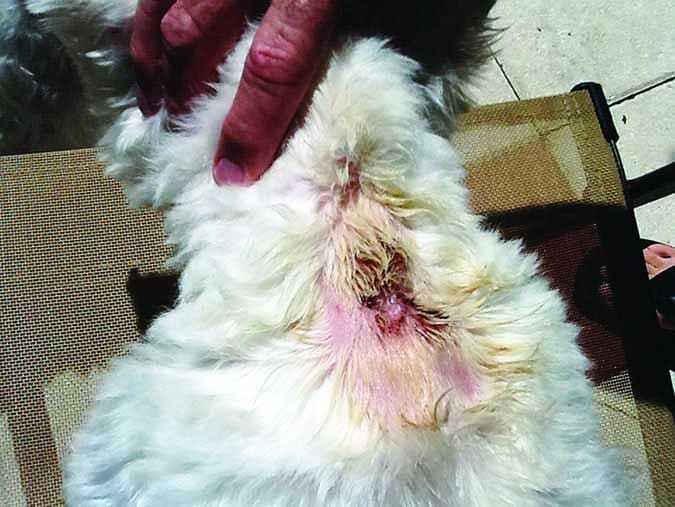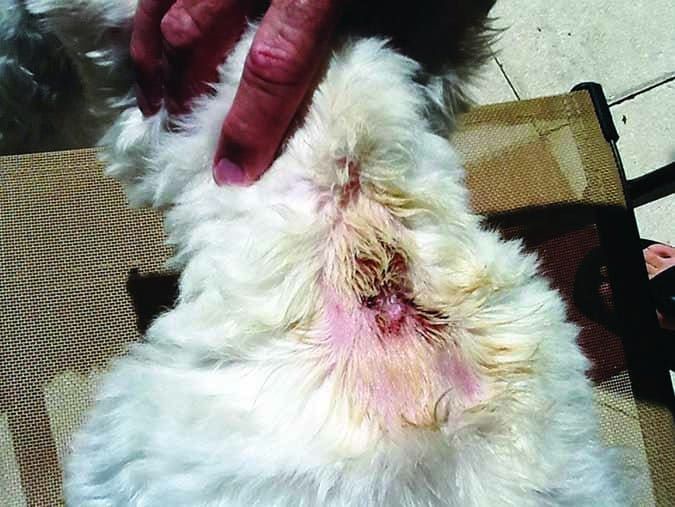In some parts of the world, I hear, fleas are not much of a problem. I’ve never been to those parts of the world. If you and your dogs live there, I suggest that you never relocate. Fleas cause dozens of canine health problems, from severe allergies (more dogs are allergic to flea bites than to anything else), damaged skin, infections and “hot spots,” worn teeth (from chewing the itchy flea bites), anemia (from a heavy infestation), and tapeworms (tapeworm larvae are often present inside fleas; when dogs consume infected fleas in the process of chewing their flea bites, they unwittingly become tapeworm hosts, as the worms develop in their digestive tract). And of course, fleas can also torment other household members, especially felines and humans.
Depending on where you live, fleas might be a minor seasonal irritation or a serious year-round problem. Some dog owners are able to control occasional infestations with nothing more than a flea comb and intensive house-cleaning. (For the uninitiated, flea combs have very fine teeth that are so close together that fleas get lodged between the teeth when you comb the dog, enabling you to trap and kill the offending insects. And one can stop a flea population from expanding if you vacuum, mop, and wash the dog’s bedding frequently – like, daily for a few weeks. Water kills flea larvae and eggs.)
But if your infestation is more serious, or your dog is super-allergic to flea bites, you may consider buying and using one of the many chemical treatments that kill or control fleas.
Of course, every product on the market has the potential for harm. Some can make certain dogs sick; some are toxic to cats; some may even pose risks to children or chemically sensitive humans in your home. But all of the products listed here are safe for most dogs (and other household members) most of the time – when used strictly as directed, and never when contraindicated.
It’s incumbent on you, however, as your dog’s guardian, to do everything in your power to educate yourself thoroughly about the products available for treating a flea infestation. Because it’s completely possible to poison your dog with a product that your best friend – or even your veterinarian! – recommended and used on their own dogs.
Oral and Spot-On Flea Medications
We’re going to discuss just two kinds of flea-control products here: oral medications and spot-on products made by the most reputable and responsible manufacturers.
There are two reasons we are excluding all the flea-killing shampoos, sprays, powders, dips, and most collars – as well as ALL the low-budget spot-ons – that are available to dog owners:
1) Almost all of these products are less effective than the products we will discuss.
2) Almost all of these products are more dangerous (more toxic) than the products we will discuss.
In fact, many products on the market are excluded by virtue of both of the two reasons listed above. We don’t recommend using any flea-control products other than the ones that appear on the next few pages – and we implore you to use them exactly as directed.
Our Flea Treatment Recommendations and Warnings
The following are our suggestions for using the most effective flea-control products on the market in the safest ways possible.
Use the Least Toxic, Simplest Product Needed
If fleas are the only insect threat to your dog, use a product that addresses fleas only. If ticks are also a problem for your dog, using a product that is made to protect him from both pests is more prudent than risking a toxic drug interaction from using two incompatible pesticides.
The same goes for a product that also offers protection from heartworm and/or intestinal worms; use one of these multi-target products if it’s needed, but don’t subject a dog who has little risk of exposure to these additional parasites to a combination product if you don’t have to.
Also, be aware that some products are highly problematic when used in combination with other pesticides. Combining spinosad (the flea control ingredient in Comfortis and Trifexis) with the high doses of ivermectin and milbemycin oxime used to treat demodectic and sarcoptic mange increases the potential for neurological side effects. Use with caution in dogs with the MDR1 mutation for the same reason.
Use These Products Infrequently, Only as Needed
The product manufacturers would love to have you administer their wares once a month, every month; their bias is profit-motivated. We recommend using them as infrequently as you can get away with. However, if you use a multi-target product for say, fleas and heartworm prevention, and you don’t need it for fleas anymore, don’t leave your dog unprotected against heartworm; use another preventative aimed at just heartworm.
Read the Entire Label, Note All Cautions, Follow All Directions
“Why should I bother? I bought this from my veterinarian!” you say. Vets and their staff members are busy, and they may not have ever read the entire label – or be familiar with your dog’s medical history – to know that a certain product is contraindicated for your dog. Pay special attention to the sections of the label and package insert that discuss “Warnings” and “Safety.” If, based on your reading, you think the product could pose a problem for your dog, don’t administer it. Instead, call your vet and discuss it with her before proceeding (or returning the product).
Be Especially Cautious If Your Dog Has Any Medical Concerns
Certain types of dogs are far more prone to experiencing adverse reactions, including death, to flea-killing products than others. Frequently mentioned on label cautions are dogs who are old, sick, debilitated, underweight, medicated, very young, or very small. Additionally, the safety of many products has not been established for dogs who are used for breeding (actually, it’s their offspring that are likely to suffer).
Use the Smallest Effective Dose of Pesticide Indicated
If your dog weighs 47 lbs, and the product you want to use is available only in doses for dogs who weigh 20-50 lbs and 50-80 pounds, choose the product for the smaller dog. If your dog is extremely small, less than 8 lbs, say, and the smallest dose of the product you are considering can treat dogs up to 25 lbs. look for a different product, one with a smaller range of doses. Extremely small dogs have more adverse reactions than larger dogs, and these inadvertent doses of 2-3 times what they really need definitely contribute to the problems. (Products containing permethrin, in particular, seem to be especially problematic for small dogs, even when dosed according to label instructions. Err on the side of caution.)

Don’t Mix Flea Control Medications
If a product is meant to be administered once a month, don’t use it more frequently than that, and don’t use any other product in that time span, either. A product can be both ineffective for its intended use and potentially harmful to your dog.
If Your Dog Takes Other Medications, Don’t Give Him Flea Control Drugs
The makers of these products have been criticized for not being as explicit or thorough as they could be in their lists of contraindications. Consider every medication your dog takes, and choose a product accordingly. For example, products containing amitraz (such as Certifect) should not be used on “medicated” dogs, such as those with diabetes or heart problems; amitraz, a monoamine oxidase inhibitor (MAOI), can be dangerous when combined with antidepressants (such as those used to treat separation anxiety), Anipryl (used for canine cognitive dysfunction and Cushing’s disease), and DL-Phenylalanine (DLPA), used to treat chronic pain.
Flea Control for Dogs Poses Special Risk to Cats
Some of these products are especially toxic to cats. If your cat shares bedding, sleeps in close proximity to, or licks and grooms your dog, don’t even consider any of the products that are potentially fatal to cats.
You Don’t Need to Experiment with Every New Flea Drug
Your veterinary staff may be promoting the latest, greatest product, and may have even, in their enthusiasm, stopped carrying a product that really worked well for your dog. Don’t feel pressured to switch! You can ask them to order the product that worked well for your dog in the past, or look for it at another clinic.
Clinical Tests for Flea Meds Aren’t That Thorough
The test dogs are likely laboratory animals, often of a single breed, and not necessarily exposed to the complex melange of environmental chemicals, foods, vaccines, illnesses, and medicines that dogs in a “real world” environment routinely experience.
Allow plenty of time for enough doses to be administered that the product’s safety is better established before you give it to your dog, especially if he’s a sensitive individual – very tiny or old, a cancer survivor or a breed that is prone to cancer, an epileptic or a breed that is prone to epilepsy, and so on.

Do Not “Apply and Forget” – Watch Your Dog Carefully
Monitor your dog closely for side effects or signs of sensitivity after administering the product, particularly when using the product for the first time. This means you shouldn’t administer a product right before you leave your dog with a sitter or boarding kennel and go on vacation; no one knows your dog as well as you do, and no one will notice subtle signs of an adverse reaction as quickly as you will. You might even consider using any new product early on the first day of a weekend when you will have ample opportunity to watch your dog for any signs of a bad reaction.
Take Action if Your Dog Has An Adverse Reaction to Any of These Products
If it’s a topical product, wash your dog as thoroughly as possible, paying special attention to the area where the spot-on was applied.
Then take your dog to the veterinarian for treatment, and make sure the vet enters thorough notes about the reaction in your dog’s file. Take photos and/or video of your dog that illustrate the problem he’s having. Document the purchase (save your receipts!) and application of the product; how and when did you administer it, and how and when did the adverse events begin?
Then, report the adverse event to the manufacturer and to the government agency responsible for regulating the type of product you used (see “How to Report an Adverse Reaction, below).
Don’t Repeat A Failure
If your dog had an adverse reaction to a product, don’t use that product again! And don’t use any other product that contains the same active ingredients!
You are stuck when it comes to the unspecified “other” ingredients in these products. Manufacturers are not required to disclose what these other ingredients are, even though it’s clear that they are sometimes responsible for dogs’ adverse reactions. If your dog has a bad reaction to a product, all you can do is to avoid using that product and others that contain the same “active” ingredients. (And, in case of adverse reactions to the “other,” undisclosed ingredients, you can only hope that the next product you try does not contain the same undisclosed ingredient.)
Note in your dog’s health diary about the product that you used, the amount, the date, and details about the dog’s reaction, and then refer to this before buying or using another product.
How to Report an Adverse Flea Medication Reaction
Any adverse reaction following the administration of a topical or oral medication should be reported to the product manufacturer. You can do this by calling the toll-free number on the product label. A technical services veterinarian from the company will ask a series of questions about the event, file the report internally and (must, by law) forward the report to the proper regulatory agency.
For the most part, pesticides are regulated in the U.S. by the Environmental Protection Agency (EPA). However, systemically active insecticides are regulated as ‘drugs’ by the Food & Drug Administration (FDA). All of the orally administered products in the list attached to this page are regulated by the FDA. And most of the spot-on products also listed are regulated by the EPA. The notable exceptions are Advantage Multi and Revolution; their ability to kill the L3 and L4 (larval) stages of heartworm and intestinal worms is due to a systemic action, so they are regulated by the FDA.
Your veterinarian can also file the report, and you should ask the clinic staff to do so — veterinarians’ reports are given more credence than reports from owners by the regulatory agencies — but it’s important that you follow up to make sure it gets done. After your dog has been seen and/or treated by your vet, call and ask whether an adverse event report was filed. If you have an inkling that it hasn’t been done and isn’t going to get done, it’s important that you file one yourself.
You can also submit a report directly to the regulatory agency. Be prepared to provide solid information about when and what product was administered (it’s ideal if you have the package), as well as details about your dog’s medical history, including his age, weight, breed, all concomitant drugs he has been given and any other recent illnesses he may have had.
To report an adverse event concerning an oral medication or a systemically active insecticide, contact the FDA Center for Veterinary Medicine. An online form for reporting an adverse event concerning a topical pesticide is available from the National Pesticide Information Center.
Many thanks to Mary Straus for her research assistance for this article.
Nancy Kerns is Editor of WDJ. Tick control is critical in her part of the Northern California woods.







Interesting article, however, I don’t see a list of products, or any product suggestions at all.
Where is the list of products mentioned in your article? My dog has reoccurring fleas
I also was expecting to find recommendations. Please give us some!
Yes please give recommendations. I’m commenting in hopes that it will notify me when you post the list of recommended treatments.
How ridiculous to state you will be listing products yet there is no list??
Where is the attached list of flea products??
The list of products is not in article at all.
Where’s the beef ? Instead of telling us what to avoid , how about a thorough description of how to keep our doggie loved-ones free of fleas w/o poisons ?
Where can I find the suggested list of flea medication you recommend? Thanks!
I, too, would like a list of acceptable, safe, non-toxic products for my little one.
No solutions just a list of bad effects, of little use if alternatives not listed.
I agree with everyone above… where is the list of recommended products, this article has no value without it.
I feel like this article did a good job in scaring the heck out of me in terms of tearing my dog and cat with commercial flea products. What I did not find was safe alternatives. REALLY???
I really wasted my money buying the WHOLE DOG JOURNAL. Just like this article, promises, but does not deliver. Other articles the want another $29.99 ! Or some other amount of money. So far I have got NO VALUE for my money. Very disappointed in The Whole Dog Journal.